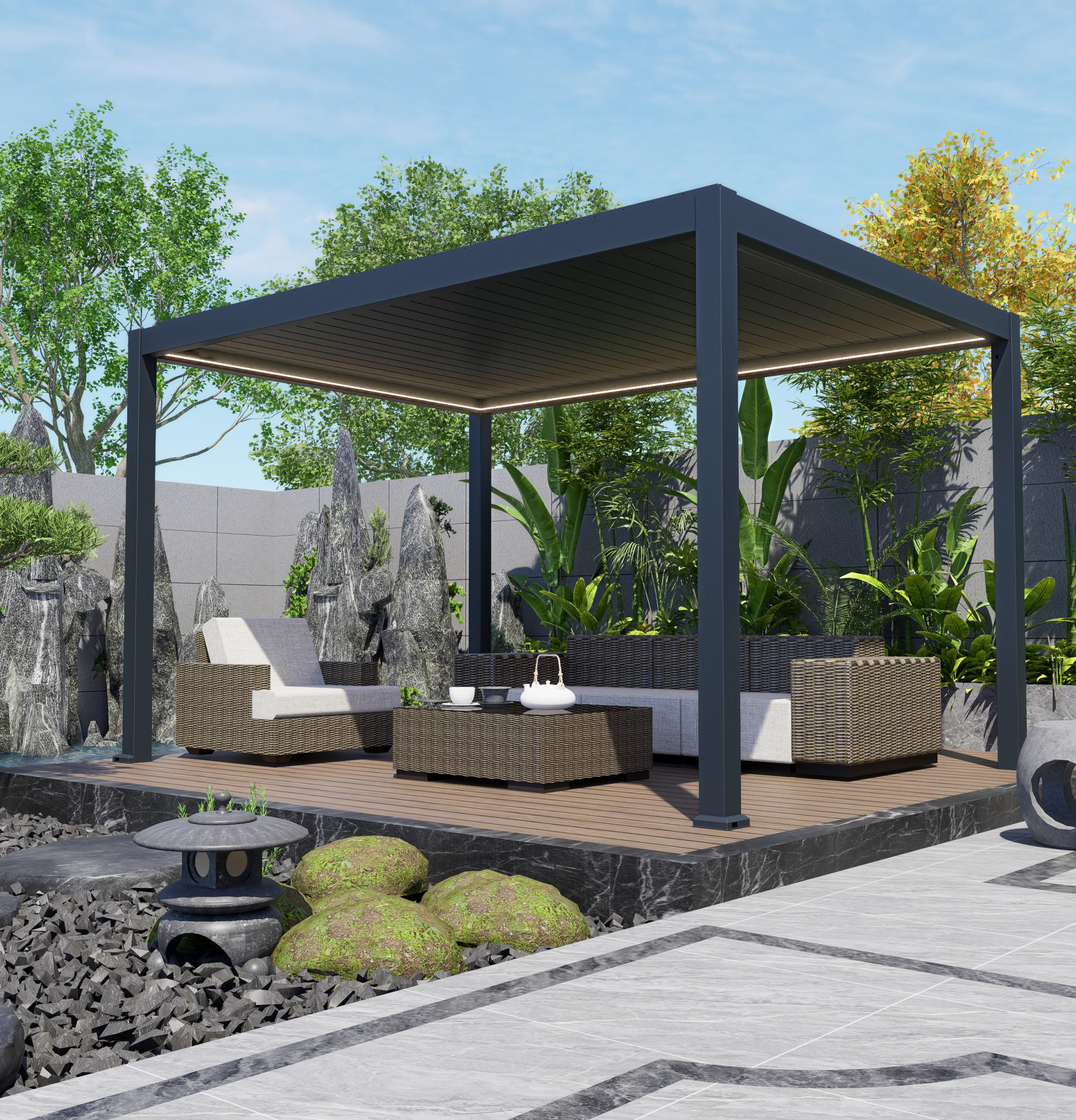Worried your beautiful aluminum pergola might sound like a drum solo during storms? Modern aluminum pergolas produce minimal rain noise - typically 40-50 decibels (about conversational volume) during moderate rainfall. With proper design choices, you can reduce this to library-quiet levels under 35dB. Let me explain the acoustic science behind these structures.
Quality aluminum pergolas create less rain noise than traditional metal roofs - about 30-40% quieter due to thicker gauge materials (typically 3-5mm) and sound-dampening coatings. The hollow chamber construction of aluminum beams actually absorbs sound waves rather than amplifying them like solid sheets. Most owners describe the rain sound as "soothing white noise" comparable to light forest rainfall.

Let's examine what creates (and prevents) noise in aluminum pergolas:
What factors determine rain noise levels?
Four key elements control how loud your pergola sounds during precipitation:
Noise-Influencing Characteristics
| Factor | Low Noise Design | High Noise Result |
|---|---|---|
| Material Thickness | 4-5mm aircraft-grade | <3mm thin sheets |
| Surface Coating | Textured powder coat | Smooth anodized |
| Roof Type | Louvered/insulated | Solid metal panels |
| Installation | Rubber isolators | Direct-to-structure |
Common noise measurements:
- Light rain (0.25"/hr): 35-45dB (refrigerator hum)
- Moderate rain (0.5"/hr): 45-55dB (normal conversation)
- Heavy rain (1"/hr): 55-65dB (background music)
- Hail (pea-sized): 65-75dB (vacuum cleaner)
How can you reduce rain noise?
These effective solutions can lower sound levels by 15-20 decibels:
Noise Reduction Methods
| Solution | Noise Reduction | Cost | Difficulty |
|---|---|---|---|
| Acoustic pads | 8-12dB | $2-4/sq ft | DIY |
| Fabric canopy | 10-15dB | $5-10/sq ft | Professional |
| Insulated roof | 12-18dB | $15-25/sq ft | Contractor |
| Rubber mounts | 6-10dB | $3-6/point | Moderate |
| Sound blankets | 5-8dB | $1-3/sq ft | Easy |
Effective materials:
- Mass-loaded vinyl: Best performance (1/8" thick)
- Closed-cell foam: Affordable option
- Fiberglass insulation: Multi-purpose
- Acoustic fabric: Dual-purpose shading
- Sorbothane pads: Premium vibration control
How does design affect acoustics?
Your pergola's structure significantly influences sound transmission:
Design Impact on Noise
| Feature | Quiet Design | Noisy Design |
|---|---|---|
| Beam Shape | Chambered hollow | Solid I-beam |
| Panel Type | Perforated | Solid sheet |
| Mounting | Floating | Fixed bolts |
| Slope | 5-10° pitch | Flat surface |
| Joists | Rubber-gasketed | Metal-on-metal |
Recommended specifications:
- 4mm+ thickness: For sound absorption
- 20%+ open area: In louvers/panels
- 1" air gaps: Between metal layers
- Textured surfaces: Break up sound waves
- Curved profiles: Deflect noise upward
What about different rainfall types?
Precipitation characteristics change the sound profile:
Rain Type Noise Levels
| Precipitation | Sound Character | Typical dB | Perception |
|---|---|---|---|
| Drizzle | Soft pattering | 30-40 | Very quiet |
| Steady rain | Rhythmic tapping | 40-50 | Noticeable |
| Downpour | Constant roar | 50-60 | Loud |
| Hail | Sharp cracks | 60-75 | Disruptive |
| Freezing rain | Tinkling ice | 45-55 | High-pitched |
Mitigation strategies:
- Polycarbonate roofs: For hail areas
- Sloped designs: For quick drainage
- Edge dams: Prevent water dripping sounds
- Gutter systems: Redirect flow noise
- Dense vegetation: Natural sound barrier
How does aluminum compare to other materials?
Aluminum performs differently than alternative pergola materials:
Material Noise Comparison
| Material | Rain Noise | Heat Expansion | Cost |
|---|---|---|---|
| Aluminum | Moderate | High | $$ |
| Wood | Lowest | Medium | $$$ |
| Vinyl | Low | High | $ |
| Steel | Highest | Medium | $$ |
| Fiberglass | Low | Low | $$$$ |
Aluminum pergolas produce moderate rain noise (45-55dB) - louder than wood but quieter than steel. With proper noise-reducing treatments, aluminum can achieve near-wood sound levels while maintaining its weather resistance and durability advantages. Most owners find the rain sounds pleasant and not disruptive, especially with open-roof designs where sound escapes upward rather than reflecting downward.


